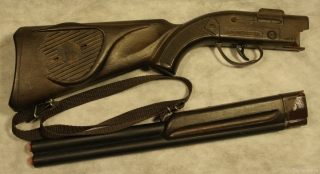Weapon toys have a special place in our children’s preferences and choices (media has a lot to do with it), should they be cheap and badly made, or made of some breakable colourless plastic, or even representing something that doesn’t exist or is simply unbelievable. All these said (and we’ll say them again), we’ll now tell the story of a half failure, a repairing that didn’t last (obviously because of us). However, there were no noticeable dramas for the little one, who considered the whole thing so naturally as in “it broke, it was fixed, it broke again and now it’s working again”… As opposed to us, the old guys, taking too much pride in our skills…”If you’d done the way I told you….” or “ Nahh, eventually I was the one…”
The history of the defect/ accident
Seeing how the split looked like the first time, that toy must have been either sat on by one of the parents or turned it into mace by the kid. However, in the case of a fully plastic Gonher rifle, having only a membrane mechanism (a kind of drum – a membrane as a speaker) driven by the trigger, its functionality wasn’t affected by the rupture in any way.
All the front side (forestock) is just for design and maybe that’s why I didn’t actually look for a real equivalent of the model (as described above: Shotgun revolver with the broken bed – July 2009).
Action plan
As it was a “clean” break, with areas that overlap on a large area, just one fracture, without “crumbs”, we proposed a newly purchased product, whose brand I won’t mention here, meant to stick together PVC parts. Its instant drying, along with the desire to try something new, made it become the ideal candidate for the job.
In stage II, I never took this leap of faith and I mended it in the old fashioned traditional way: solvent, with the pieces caught in the vice, and 24 hours time for drying.
Necessary tools and parts
As I mentioned above, the break was clean, so all we needed was adhesive (glue, glue, … superglue!). Or so I thought at my first attempt.
When I discovered that this was not enough, I applied the classical solution with a bank to keep the gun in thevise, belt fasteners, plus a scalpel or curette Scaler , as the Saxons call it, a tool with a sharp point to clean the old adhesive.
The repairing process
Round I: it went very simple: spread the glue, held the gun held fixed for a minute and sent the kiddo to play. As in many other cases, taking the pictures lasted more than actually doing the job….
Round II was slightly different: cleaning, photographing, and then thoroughly pasting with solvent (dichloroethane), then fixing it in the vice and elastic bands for 24 hours – the way it has to be done and the way we learned to do it.
The final result
After the first soldering, the fixed split broke on the same line – an advantage for us and this allowed us to restore its structural integrity at the second attempt. The next split ( God forbid!!!…) will take place in another area, or even parallel with the old break, if the gun will be subject to the same treatment. I noticed this whenever I used solvent to glue, and is a common manifestation in most welds (made right). We won’t go into details, but it’s about the crystalline structure of metal (for welding) and the structure of long polymers (or long chains?) or so for plastic.
Other comments
To be fair, without unnecessarily hampering an adhesive product or another, the original compound is good, but had no grip on type of plastic the gun was made of, which actually helped us. Much better than an adhesive failure, when it would have remained stuck in plastic and we would have had to clean the whole mess…
Available images:
















